weight MERCEDES-BENZ S CLASS 2019 User Guide
[x] Cancel search | Manufacturer: MERCEDES-BENZ, Model Year: 2019, Model line: S CLASS, Model: MERCEDES-BENZ S CLASS 2019Pages: 578, PDF Size: 23.31 MB
Page 444 of 578
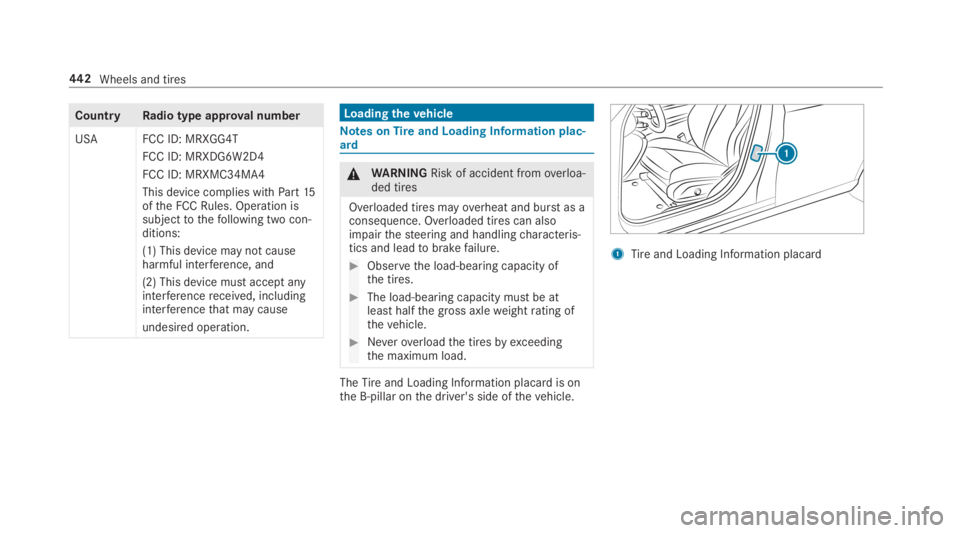
CountryRadio type approval number
USAFCC ID: MRXGG4T
FCC ID: MRXDG6W2D4
FCC ID: MRXMC34MA4
This device complies withPart15ofthe FCCRules. Operation issubjecttothefollowing two con‐ditions:
(1) This device may not causeharmful interference, and
(2) This device mustaccept anyinterferencereceived, includinginterferencethat may cause
undesired operation.
Loadingthevehicle
Notes onTireand Loading Information plac‐ard
&WARNINGRisk of accident fromoverloa‐ded tires
Overloaded tires mayoverheat and burstas aconsequence. Overloaded tires can alsoimpairthesteering and handlingcharacteris‐tics and leadtobrakefailure.
#Observethe load-bearing capacity ofthe tires.
#The load-bearing capacity must be atleast halfthe gross axleweightrating ofthevehicle.
#Neveroverloadthe tiresby exceedingthe maximum load.
TheTireand Loading Information placard is onthe B-pillar onthe driver's side ofthevehicle.
1Tireand Loading Information placard
442Wheels and tires
Page 445 of 578
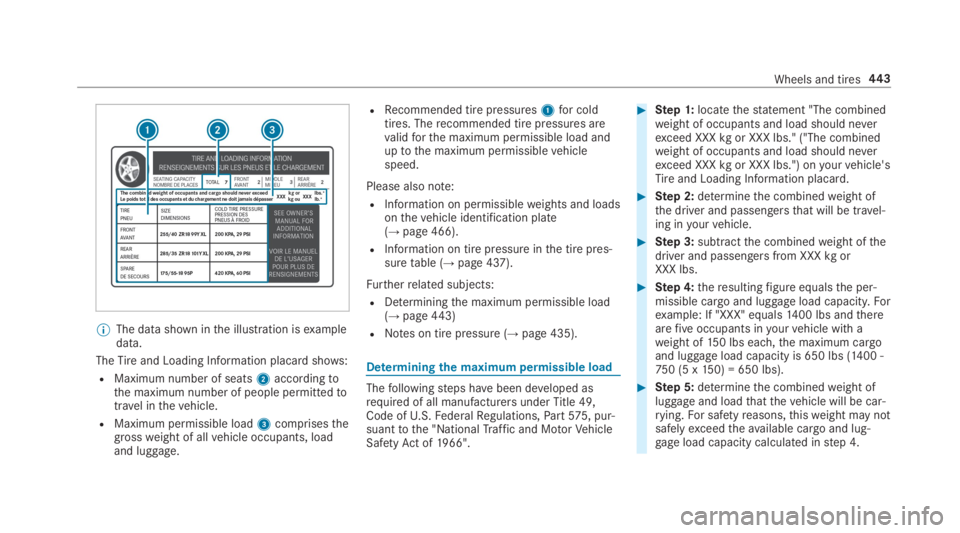
%The data shown inthe illustration isexampledata.
TheTireand Loading Information placard shows:
RMaximum number of seats2accordingtothe maximum number of people permittedtotravel inthevehicle.
RMaximum permissible load3comprisesthegrossweight of allvehicle occupants, loadand luggage.
RRecommended tire pressures1for coldtires. Therecommended tire pressures arevalidforthe maximum permissible load anduptothe maximum permissiblevehiclespeed.
Please also note:
RInformation on permissibleweights and loadsonthevehicle identification plate(→page 466).
RInformation on tire pressure inthe tire pres‐suretable (→page 437).
Furtherrelated subjects:
RDeterminingthe maximum permissible load(→page443)
RNotes on tire pressure (→page 435).
Determiningthe maximum permissible load
Thefollowingsteps havebeen developed asrequired of all manufacturers underTitle 49,Code ofU.S.FederalRegulations,Part575, pur‐suanttothe "NationalTraffic and MotorVehicleSafetyAct of1966".
#Step 1:locatethestatement "The combinedweight of occupants and load should neverexceed XXXkgor XXX lbs." ("The combinedweight of occupants and load should neverexceed XXXkgor XXX lbs.") onyourvehicle'sTireand Loading Information placard.
#Step 2:determinethe combinedweight ofthe driver and passengersthat will be travel‐ing inyourvehicle.
#Step 3:subtractthe combinedweight ofthedriver and passengers from XXXkgorXXX lbs.
#Step 4:theresultingfigure equalsthe per‐missible cargo and luggage load capacity.Forexample: If "XXX" equals1400 lbs andtherearefiveoccupants inyourvehicle with aweight of150 lbs each,the maximum cargoand luggage load capacity is 650 lbs (1400 -750 (5 x150) = 650 lbs).
#Step 5:determinethe combinedweight ofluggage and loadthatthevehicle will be car‐rying.For safetyreasons,thisweight may notsafelyexceedtheavailable cargo and lug‐gageload capacity calculated instep 4.
Wheels and tires443
Page 446 of 578
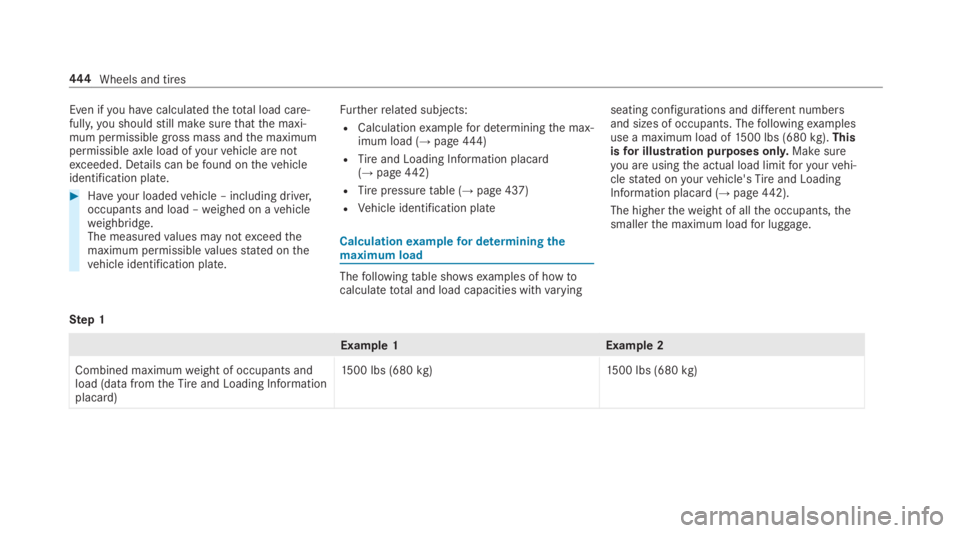
Even ifyou havecalculatedthetotal load care‐fully,you shouldstill make surethatthe maxi‐mum permissible gross mass andthe maximumpermissible axle load ofyourvehicle are notexceeded. Details can befound onthevehicleidentification plate.
#Haveyour loadedvehicle – including driver,occupants and load –weighed on avehicleweighbridge.The measuredvalues may notexceedthemaximum permissiblevaluesstated onthevehicle identification plate.
Furtherrelated subjects:
RCalculationexamplefor determiningthe max‐imum load (→page444)
RTireand Loading Information placard(→page442)
RTirepressuretable (→page 437)
RVehicle identification plate
Calculationexamplefor determiningthemaximum load
Thefollowingtable showsexamples of howtocalculatetotal and load capacities withvarying
seating configurations and different numbersand sizes of occupants. Thefollowingexamplesuse a maximum load of1500 lbs (680kg).Thisisfor illustration purposes only.Make sureyou are usingthe actual load limitforyourvehi‐clestated onyourvehicle'sTireand LoadingInformation placard (→page442).
The highertheweight of allthe occupants,thesmallerthe maximum loadfor luggage.
Step 1
Example1Example 2
Combined maximumweight of occupants andload (data fromtheTireand Loading Informationplacard)
1500 lbs (680kg)1500 lbs (680kg)
444Wheels and tires
Page 447 of 578
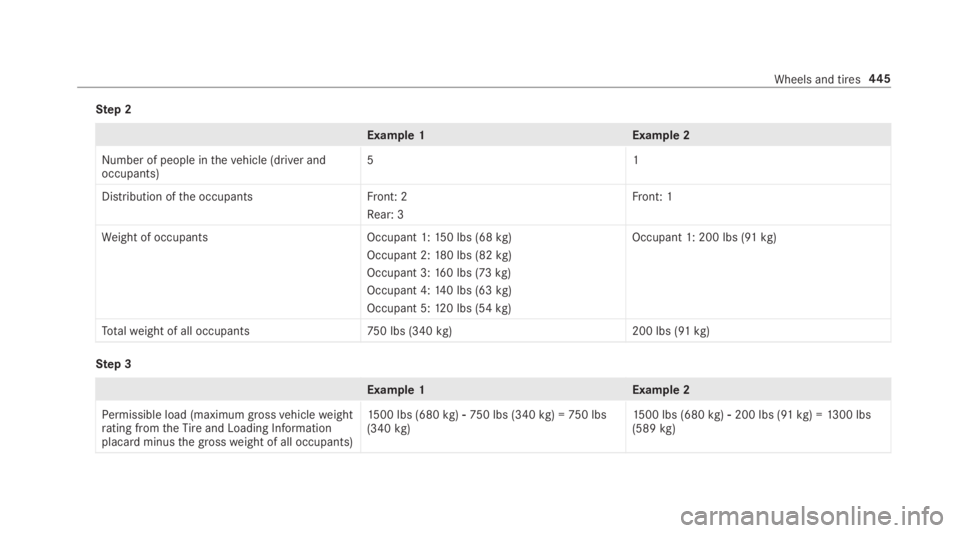
Step 2
Example1Example 2
Number of people inthevehicle (driver andoccupants)51
Distribution ofthe occupantsFront: 2
Rear: 3
Front: 1
Weight of occupantsOccupant 1:150 lbs (68kg)
Occupant 2:180 lbs (82kg)
Occupant 3:160 lbs (73kg)
Occupant 4:140 lbs (63kg)
Occupant 5:120 lbs (54kg)
Occupant 1: 200 lbs (91kg)
Totalweight of all occupants750 lbs (340kg)200 lbs (91kg)
Step 3
Example1Example 2
Permissible load (maximumgrossvehicleweightrating fromtheTireand Loading Informationplacard minusthe grossweight of all occupants)
1500 lbs (680kg)�
Page 450 of 578
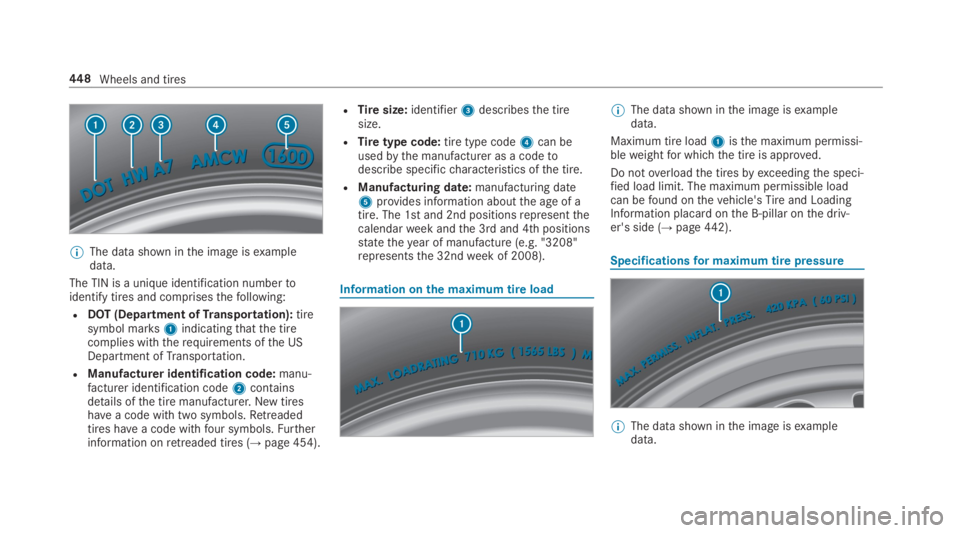
%The data shown inthe image isexampledata.
The TIN is a unique identification numbertoidentify tires and comprisesthefollowing:
RDOT (Department ofTransportation):tiresymbol marks1indicatingthatthe tirecomplies withtherequirements ofthe USDepartment ofTransportation.
RManufacturer identification code:manu‐facturer identification code2containsdetails ofthe tire manufacturer. New tireshavea code with two symbols.Retreadedtires havea code withfour symbols.Furtherinformation onretreaded tires (→page454).
RTiresize:identifier3describesthe tiresize.
RTiretype code:tire type code4can beusedbythe manufacturer as a codetodescribe specificcharacteristics ofthe tire.
RManufacturing date:manufacturing date5provides information aboutthe age of atire. The 1st and 2nd positionsrepresentthecalendarweek andthe 3rd and 4th positionsstatetheyear of manufacture (e.g. "3208"representsthe 32ndweek of 2008).
Information onthe maximum tire load
%The data shown inthe image isexampledata.
Maximum tire load1isthe maximum permissi‐bleweightfor whichthe tire is approved.
Do notoverloadthe tiresby exceedingthe speci‐fied load limit. The maximum permissible loadcan befound onthevehicle'sTireand LoadingInformation placard onthe B-pillar onthe driv‐er's side (→page442).
Specificationsfor maximum tire pressure
%The datashown inthe image isexampledata.
448Wheels and tires
Page 453 of 578
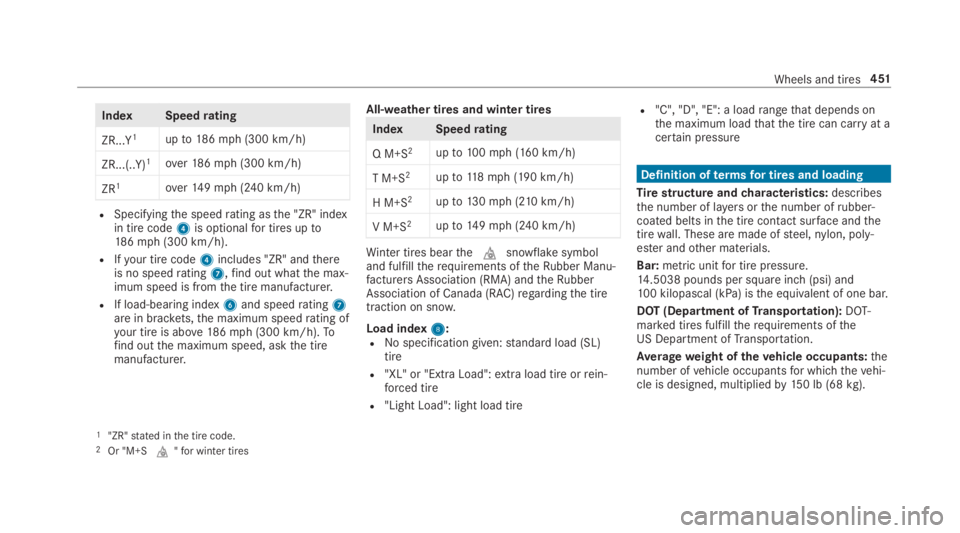
IndexSpeedrating
ZR...Y1upto186mph (300 km/h)
ZR...(..Y)1over186mph (300 km/h)
ZR1over149mph (240 km/h)
RSpecifyingthe speedrating asthe "ZR" indexin tire code4is optionalfor tires upto186mph (300 km/h).
RIfyour tire code4includes "ZR" andthereis no speedrating7,find out whatthe max‐imum speed is fromthe tire manufacturer.
RIf load-bearing index6and speedrating7are in brackets,the maximum speedrating ofyour tire is above186mph (300 km/h).Tofind outthe maximum speed, askthe tiremanufacturer.
All-weather tires and winter tires
IndexSpeedrating
Q M+S2upto100mph (160 km/h)
T M+S2upto118mph (190 km/h)
H M+S2upto130mph (210km/h)
V M+S2upto149mph (240 km/h)
Winter tires bearthe�Msnowflake symboland fulfilltherequirements oftheRubber Manu‐facturers Association (RMA) andtheRubberAssociation of Canada (RAC)regardingthe tiretraction on snow.
Load index88:RNo specification given:standard load (SL)tire
R"XL" or "Extra Load":extra load tire orrein‐forced tire
R"Light Load": light load tire
R"C", "D", "E": a loadrangethat depends onthe maximum loadthatthe tire can carryat acertain pressure
Definition oftermsfor tires and loading
Tirestructureandcharacteristics:describesthe number of layersorthe number ofrubber-coated belts inthe tire contact surface andthetirewall. These are made ofsteel,nylon, poly‐ester andother materials.
Bar:metric unitfor tire pressure.14.5038 pounds per square inch (psi) and100 kilopascal (kPa) isthe equivalent of one bar.
DOT (Department ofTransportation):DOT-marked tires fulfilltherequirements oftheUS Department ofTransportation.
Averageweight ofthevehicle occupants:thenumber ofvehicle occupantsfor which thevehi‐cle is designed, multipliedby150 lb (68kg).
1"ZR"stated inthe tire code.2Or "M+S�M"for winter tires
Wheels and tires451
Page 454 of 578
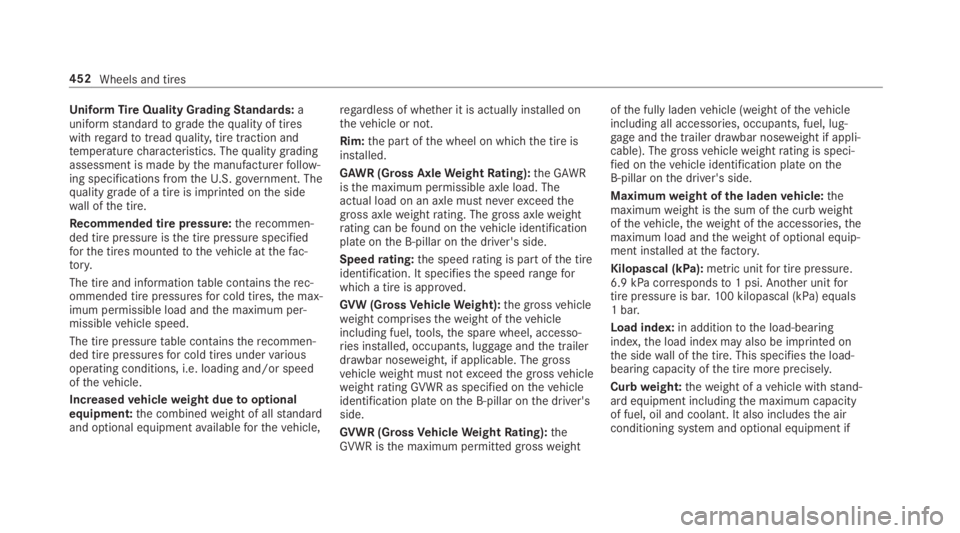
UniformTireQuality GradingStandards:auniformstandardtogradethequality of tireswithregardtotreadquality,tire traction andtemperaturecharacteristics. Thequality gradingassessment is madebythe manufacturerfollow‐ing specifications fromtheU.S. government. Thequalitygrade of a tire is imprinted onthe sidewall ofthe tire.
Recommended tire pressure:therecommen‐ded tire pressure isthe tire pressure specifiedforthe tires mountedtothevehicle atthefac‐tory.
The tire and informationtable containstherec‐ommended tire pressuresfor cold tires,the max‐imum permissible load andthe maximum per‐missiblevehicle speed.
The tire pressuretable containstherecommen‐ded tire pressuresfor cold tires undervariousoperating conditions, i.e. loading and/or speedofthevehicle.
Increasedvehicleweight duetooptionalequipment:the combinedweight of allstandardand optional equipmentavailableforthevehicle,
regardless of whether it is actually installed onthevehicle or not.
Rim:the part ofthe wheel on whichthe tire isinstalled.
GAWR (Gross AxleWeightRating):the GAWRisthe maximum permissible axle load. Theactual load on an axle must neverexceedthegrossaxleweightrating. The gross axleweightrating can befound onthevehicle identificationplate onthe B‑pillar onthe driver's side.
Speedrating:the speedrating is partofthe tireidentification. It specifiesthe speedrangeforwhich a tire is approved.
GVW (GrossVehicleWeight):the grossvehicleweight comprisestheweight ofthevehicleincluding fuel,tools,the spare wheel, accesso‐ries installed, occupants, luggage andthe trailerdrawbar noseweight, if applicable. Thegrossvehicleweight must notexceedthe grossvehicleweightratingGVWR as specified onthevehicleidentification plate onthe B‑pillar onthe driver'sside.
GVWR (GrossVehicleWeightRating):theGVWR isthe maximum permitted grossweight
ofthe fully ladenvehicle (weight ofthevehicleincluding all accessories, occupants, fuel, lug‐gageandthe trailer drawbar noseweight if appli‐cable). Thegrossvehicleweightrating is speci‐fied onthevehicle identification plate ontheB‑pillar onthe driver's side.
Maximumweight ofthe ladenvehicle:themaximumweight isthe sum ofthe curbweightofthevehicle,theweight ofthe accessories,themaximum load andtheweight of optional equip‐ment installed atthefactory.
Kilopascal (kPa):metric unitfor tire pressure.6.9 kPa correspondsto1 psi. Another unitfortire pressureis bar.100 kilopascal (kPa) equals1 bar.
Load index:in additiontothe load-bearingindex,the load index may also be imprinted onthe sidewall ofthe tire. This specifiesthe load-bearing capacity ofthe tire more precisely.
Curbweight:theweight of avehicle withstand‐ard equipment includingthe maximum capacityof fuel, oil and coolant. It also includesthe airconditioning system and optional equipment if
452Wheels and tires
Page 455 of 578
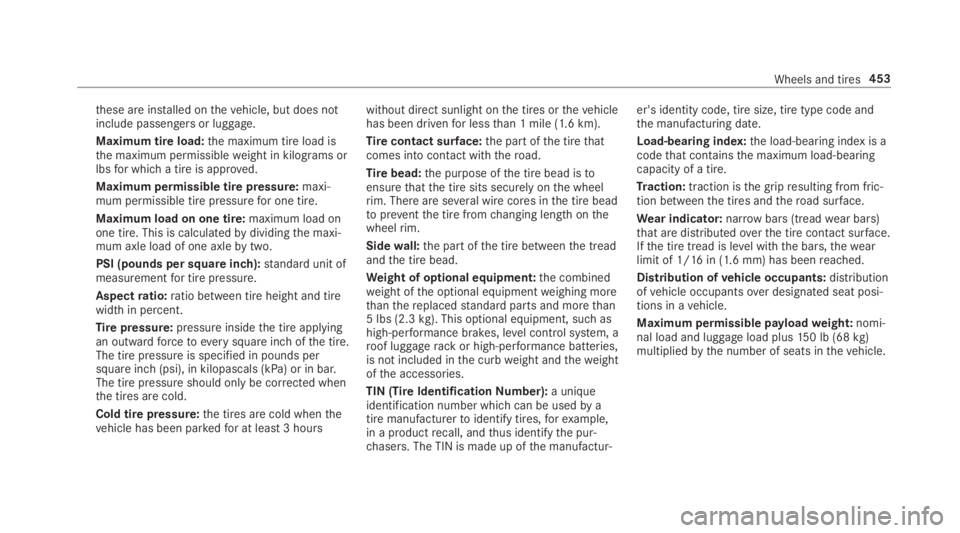
these are installed onthevehicle, but does notinclude passengers or luggage.
Maximum tire load:the maximum tire load isthe maximum permissibleweight in kilograms orlbsfor whicha tire is approved.
Maximum permissible tire pressure:maxi‐mum permissible tire pressurefor one tire.
Maximum load on one tire:maximum load onone tire. This is calculatedbydividingthe maxi‐mum axle load of one axlebytwo.
PSI (pounds per square inch):standard unit ofmeasurementfor tire pressure.
Aspectratio:ratio between tire height and tirewidth in percent.
Tirepressure:pressure insidethe tire applyingan outwardforcetoeverysquare inch ofthe tire.The tire pressure is specified in pounds persquare inch (psi), in kilopascals (kPa) or in bar.The tire pressure should only be corrected whenthe tires are cold.
Cold tire pressure:the tires are cold whenthevehicle has been parkedfor at least3 hours
without direct sunlight onthe tires orthevehiclehas been drivenfor lessthan 1 mile (1.6 km).
Tirecontact surface:the part ofthe tirethatcomes into contact with theroad.
Tirebead:the purpose ofthe tire bead istoensurethatthe tire sits securely onthe wheelrim. There are several wire cores inthe tire beadtopreventthe tire fromchanging length onthewheelrim.
Sidewall:the part ofthe tire betweenthe treadandthe tire bead.
Weight of optional equipment:the combinedweight ofthe optional equipmentweighing morethanthereplacedstandard parts and morethan5 lbs (2.3kg).This optional equipment, such ashigh-performance brakes, level control system, aroof luggagerackor high-performance batteries,is not included inthe curbweight andtheweightofthe accessories.
TIN (Tire IdentificationNumber):a uniqueidentification number which can be usedby atire manufacturertoidentify tires,forexample,in a productrecall, andthus identifythe pur‐chasers. The TIN is made up ofthe manufactur‐
er's identity code, tire size, tire type code andthe manufacturing date.
Load-bearing index:the load-bearing index is acodethat containsthe maximum load-bearingcapacity of a tire.
Traction:traction isthe gripresulting from fric‐tion betweenthe tires andtheroad surface.
Wear indicator:narrowbars (treadwear bars)that are distributedoverthe tire contact surface.Ifthe tire tread is level withthe bars,thewearlimit of 1/16in (1.6 mm) has beenreached.
Distribution ofvehicle occupants:distributionofvehicle occupantsover designated seat posi‐tions in avehicle.
Maximum permissible payloadweight:nomi‐nal load and luggage load plus150 lb (68kg)multipliedbythe number of seats inthevehicle.
Wheels and tires453
Page 468 of 578
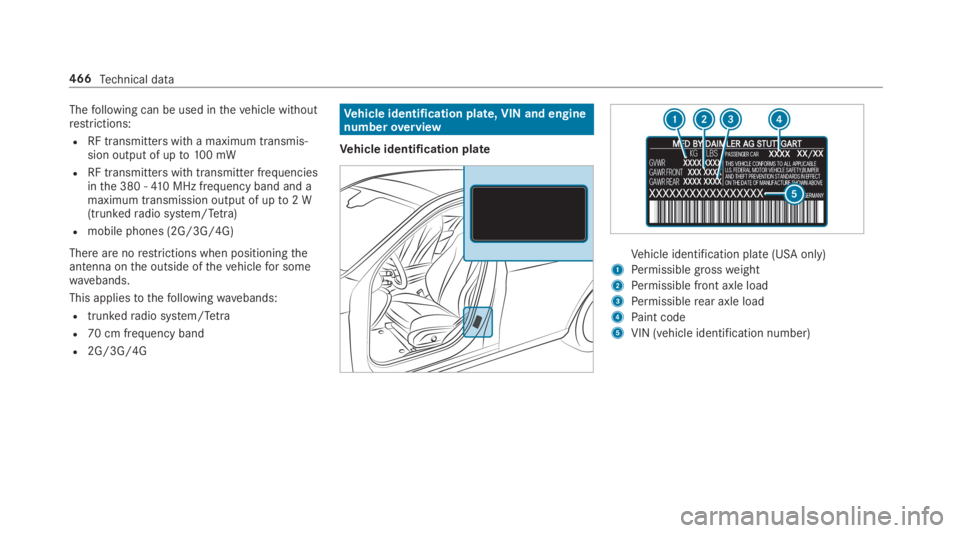
Thefollowing can be used inthevehicle withoutrestrictions:
RRF transmitters witha maximum transmis‐sion output of upto100 mW
RRF transmitters with transmitter frequenciesinthe 380 -410 MHz frequency band and amaximum transmission output of upto2 W(trunkedradio system/Tetra)
Rmobile phones (2G/3G/4G)
There are norestrictions when positioningtheantenna onthe outside ofthevehiclefor somewavebands.
This appliestothefollowingwavebands:
Rtrunkedradio system/Tetra
R70 cm frequency band
R2G/3G/4G
Vehicle identification plate, VIN and enginenumberoverview
Vehicle identification plate
Vehicle identification plate (USA only)
1Permissiblegrossweight
2Permissible front axle load
3Permissiblerear axle load
4Paint code
5VIN (vehicle identification number)
466Technical data
Page 469 of 578
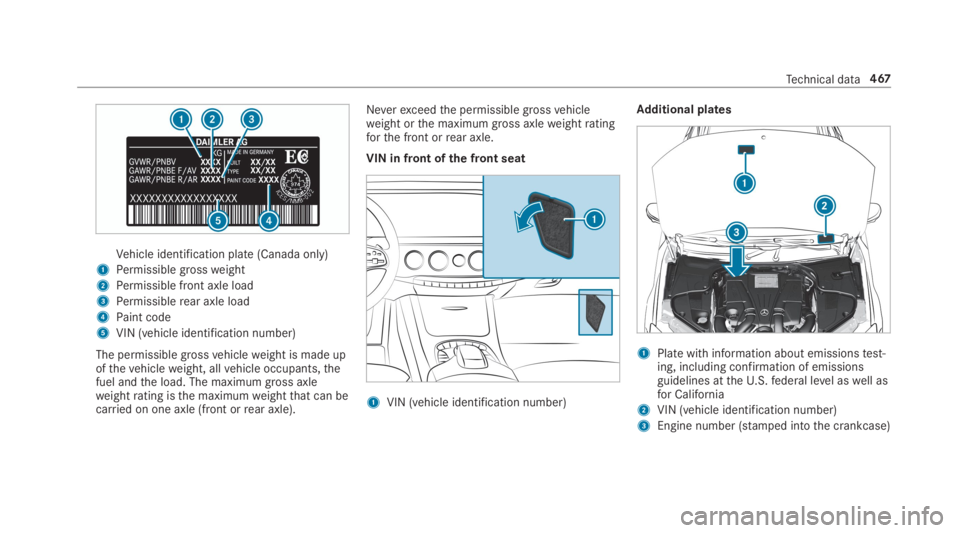
Vehicle identification plate (Canada only)
1Permissiblegrossweight
2Permissible front axle load
3Permissiblerear axle load
4Paint code
5VIN (vehicle identification number)
The permissible grossvehicleweight is made upofthevehicleweight, allvehicle occupants,thefuel andthe load. The maximum gross axleweightrating isthe maximumweightthat can becarried on one axle (front orrear axle).
Neverexceedthe permissible grossvehicleweight orthe maximum gross axleweightratingforthe front orrear axle.
VIN in front ofthe front seat
1VIN (vehicle identification number)
Additional plates
1Platewith information about emissionstest‐ing, including confirmation of emissionsguidelines attheU.S.federal level aswell asfor California
2VIN (vehicle identification number)
3Engine number (stamped intothe crankcase)
Technical data467